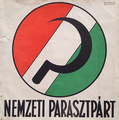
National Peasants' Party - Peace among peasants - Peace among Hungarians - Peace among nations
Hungarian title:
Nemzeti Parasztpárt - Békét a parasztok között - Békét a magyarok között - Békét a népek között régi plakát
Artist:
György Hámori
Size:
A1 1 Sheet (cca. 84 x 59 cm)
Year:
1947
Condition:
FIne, restored, backed on linen.
Material:
Paper, offset lithography.
Price: US$4000
Description:
National Peasants' Party - Peace among peasants - Peace among Hungarians - Peace among nations is a 1947 vintage Hungarian political election propaganda poster designed by Gyorgy Hamori.
Political poster from the time of a short-lived demmocracy following World War II. The year of the poster (1947) was an emblematic year in the history of Hungarian elections.
The Natoional Peasants' Party (NPP), established in 1939, but only became official in 1944 when it won 42 seats in the National Interim Assembly elections in 1944. In the next it was only 23 seats, while the following year the party won 36 of the 411 seats.
The Hungarian parliamentary elections of 1947, which later were refferred to as the infamous "blue-ballot" elections, were held on 31 August 1947.
It was a step into the direction of dictatorship, the first election when the Hungarian Communist Party managed to get the majority of the votes, but not the absolute majority (despite they cheated). Yet, their tactics to eliminate their strongest opponent, the Smallholders' Party, proved to be successful. It was in the next election when the Hungarian Worker's Party could win absolute power - only with an election fraud - they managed to incorporate the Social Democratic Party as well as The National Peasants' Party. The tactics of the Communist Party is referred to as 'salami tactics', meaning that they sliced up the enemy step by step. In 1949 a new, dictatorial era begun.
The composition contains strong symbols that carried extra meaning in the devastated post-war political scene: the white pigeon symbolizes peace, wheat symbolizes prosperity. The distant village refers to the agricultural focus of the party's political program.
The few propaganda material left from the eventful political scenery of the three years following the war, are unique historical relics from an era when people still had hope in the power of democracy.











